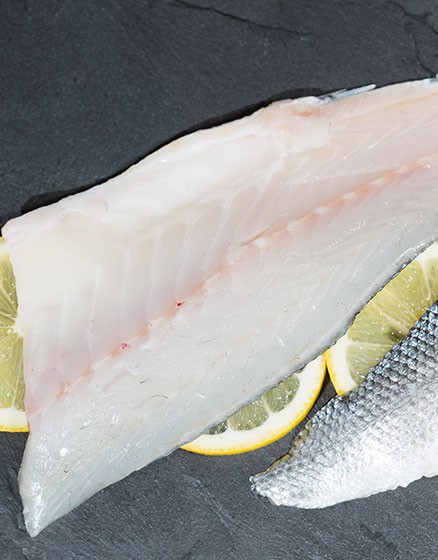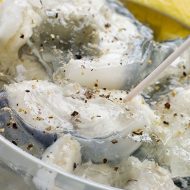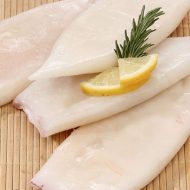The delicate taste of sea bass, either pan-fried, grilled or poached, can add an aspect of elegance to every meal. Sea bass is known to contain high amounts of omega-3s, but, from a culinary standpoint, these are not considered oily.
Processing Sea Bass
Within the required calibration ranges, sea bass is classified according to their original dimensions. It is categorised according to consumer requirements. Each fish’s head, tail, fin, and bones are all removed, and afterwards, they are filleted. The fish are gutted then the gills and scales are removed. Proper handling of the sea bass before storage and quick freezing after processing helps preserve the quality of the taste and texture of the fish.
They can be stored in good conditions for a longer time, like other fish, by keeping them in frozen storage. Seafood products kept in their original package and under ideal conditions and at a temperature of 0 °C can be preserved intact for 14 days and frozen for 18 months at -18 °C.
Benefits Of Frozen Sea Bass
Sea bass has low calories and contains high levels of selenium, omega-3 fatty acids, and protein. It tends to minimise the risk of cardiovascular disease, avoids elevated blood pressure and high cholesterol. It has a high omega-3 fatty acid content, a healthy fat that is important for the body’s regulation of HDL cholesterol. Reducing the chances of cancer is often linked with it.
In contrast to red meat, the protein derived from sea bass is healthy. It is filled with enough nutrients and protein to lose weight. Protein tends to reduce the chances of chronic illnesses that are crucial for normal growth and development. It aids in muscle, tissue and bone restoration.
There is a high level of vitamin A in sea bass, which is an antioxidant associated with vision and eye protection. It helps avoid exposure to free radicals, which might lead to eye problems. This is a good source of selenium, calcium, magnesium, zinc, and other minerals that strengthen the bone.
Why Buy Frozen Sea Bass From Us?
Frozen Fish Direct procures sea bass and other seafood and processes it to our nearby production units. We have access to global pricing’s real-time market statistics so that we can supply you with outstanding quality sea bass at great prices. Our quality management team is highly efficient. The newly captured Sea Bass is then filleted, processed and frozen within hours, guaranteeing that only the finest fish is delivered. They are manufactured and sealed in germ-free packages and then delivered.
All our fish and seafood are sustainably harvested, preserving the surrounding ocean habitat.
Frozen Sea Bass Nutritional Facts
A 1-ounce serving of Sea Bass provides:
Calories: 27.5
Calories from Fat: 5.1
Total Fat: 0.6g
Cholesterol: 11.6mg
Sodium: 19.3mg
Potassium: 72.6mg
Carbohydrates: 0g
Sugar: 0g
Fibre: 0g
Protein: 5.2g
Vitamin A: 43.7IU
Vitamin D: 64.1IU
Calcium: 2.8mg
Iron: 0.1mg
Magnesium: 11.6mg
Phosphorus: 55mg
Selenium: 10.3μg
FAQs
Is it possible to cook sea bass from frozen?
You may bypass the thawing procedure and cook frozen Sea bass straight from the freezer. You may have to increase the cooking time by a couple of minutes, and you can simply poach, steam, fry, broil or grill the sea bass direct from the freezer.
Is sea bass a healthy fish that you can eat?
Sea bass, like some other healthy fish, is high in omega-3s including protein. They also are a great source of phosphorus, manganese, and vitamin B12.
What is the taste of sea bass?
Sea bass is a white fish with a medium, delicate taste that is comparable to grouper or cod with a slight sweetness. The skin, with strong medium-sized flakes like haddock, is juicy, buttery, and soft. For individuals with a delicate palate who do not like "fishy tasting" seafood, sea bass is an outstanding choice.
Do you need to descale the sea bass?
Sea bass has thick scales and sharp fins that need to be removed before cooking. The skin can be discarded, but chefs normally keep it on as it is a good source of nutrition and once it hits the frying pan, it brings a nice texture and colour.
How do you know when the sea bass is cooked?
The easiest approach to know whether the fish is cooked is to use a fork at an angle and twist softly at the thickest portion of the fish. Once it is done, the fish would flake easily and then it will lose its transparent or raw appearance. To correctly cook fish, its internal temperature should be cooked to reach up to a minimum of 140 to 145 degrees.
















